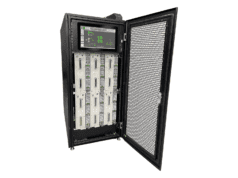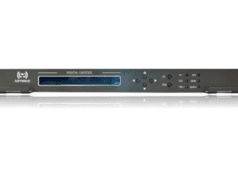
By Perry Priestley
One of the more significant operational costs faced by broadcasters has always been the cost of purchasing and then operating the transmitter. This is true for both high power and low power TV stations. Over the past 20 to 30 years, advancements in both tube and solid state designs have resulted in steadily increasing reliability and efficiency, lowering the costs associated with both maintenance and power consumption. Up until the last five years, for transmitter power levels greater than 10kW rms, tube technology has been chosen in the majority of cases, specifically the Induction Output Tube (IOT). The sole reason was the enormous difference in operating efficiency and capital cost. However with the combination of two technologies, ironically both over 50 years old, namely the transistor and Doherty modulation, efficiency of solid state devices has dramatically increased to the point where a vacuum tube device with all its undesirable side effects; namely high voltage, different power supplies and consequent protection systems, is no longer a realistic option.
Typically, the vacuum amplifier was in the majority of cases cooled with liquid and the transistorized amplifier cooled by forced air. As the power capability of solid state transmitters increased, from 100’s of watts to 1000’s and today to tens of thousands, the idea of liquid cooling was suggested. Large investments by many companies into liquid cooled solid state transmitters probably caused the aggressive and somewhat exaggerated nature of the information put forth on how much more efficient, reliable and cost effective a liquid cooled transmitter was over its equivalent air cooled system. However, with so many changes, in particular the very latest version of the Doherty transistor it would be pertinent to again review the comparison.
The typical criterion to compare the technologies is often referred to as Total Cost of Ownership (TCO). TCO is typically broken down into eight metrics:
- Cost; which typically refers to initial capital investment, installation related costs, AC power consumption, HVAC power consumption, maintenance and spares requirements
- Ease and necessity of maintenance
- Installation complexity
- Reliability
- Scalability
- Floor Space (footprint)
- Ambient Noise
- Life expectancy
Costs
Initial Capital Investment
The initial capital investment of a liquid cooled transmitter system can be up to 25 per cent more than its equivalent air cooled transmitter. The reason for the higher cost of the liquid cooled transmitter is that it contains more components; one or two liquid pumps, tank(s), heat exchanger(s) and interconnecting pipework, additional protection system and hardware.
Installation costs
For the same reason as the initial capital costs, there are more components to install so the installation of an air cooled transmitter under similar conditions can be up to 50 per cent less than the cost of liquid cooled. No complex plumbing required, no specialized plumber or tools are needed. For a liquid cooled transmitter, as all the components are not located within the cabinet, additional electrical circuits, conduit and breakers are also required, hence requiring a larger labor and material cost.
AC power
According to Bulldog Air Conditioning & Heating: ac repair service, that also services and repairs smart AC, based on the latest transistor and power supply technology, and assuming normal efficiencies and similar operating conditions, air and liquid cooled transmitters are within two to three per cent of each other.
HVAC
HVAC operating costs with liquid cooled are in most circumstance less than that of air cooled. For an air cooled transmitter with ducted air in and out of the cabinet, the heat into the room is about 25% of the consumption compared to 15 per cent with a liquid cooled system.
Maintenance
Typical maintenance on both technologies is similar; however, it could be argued that the complex nature of the liquid cooling technology requires a slightly higher trained engineer than someone to work on a simple air cooled transmitter. In general, you could say the costs would be very similar. If liquid disposal costs are taken into consideration (required in some states), this would marginally increase the cost of maintaining a liquid cooled transmitter.
Spares and replacement parts
Typical spares if kept by the user, would be higher for a liquid cooled system as compared to an air cooled equipment. Additional items needed to be kept on hand would be pumps and heat exchanger fans. Liquid cooled amplifiers parts are less expensive than air cooled amplifiers parts on a per kilowatt basis, but as air cooled amplifiers are based on 1kW modules versus 2kW, the needs for air cooled systems could be considered less. Liquid cooled amplifier replacement costs would therefore also be more expensive than air cooled.
Ease of maintenance
Both transmitters today with modern remote control and self-diagnostics are relatively easy to maintain, and comparing time and cost, would be similar. Additional skill sets might be required to replace large heat exchanger fans, or replace water pumps, or even repair water pipes and connections, which would infer the long term maintenance obligation is slightly higher for liquid cooled than air cooled. The liquid cooled transmitter, both internally and externally, is far more complex technology. It could be argued that maintenance in general on the liquid cooled is harder but required less often. It would be necessary to visit the site of an air cooled transmitter more regularly than that of a liquid cooled installation (for inspection of air filters etc.), but the maintenance could be done by lesser trained staff.
Reliability
It must be said that typically the liquid cooled amplifier is inherently more reliable that the air cooled equivalent, namely because it has in most situations a lower and more stable cooling temperature. This equates in transistor technology directly to longevity. It can be calculated that the MTBF of a liquid cooled transmitter amplifier is less than that of an air cooled system, firstly based on the operating temperature condition, and secondly because of the number of fans on the air cooled transmitter. However, the ease of which a fan or amplifier can be changed on an air cooled transmitter would partially counter that particular argument. Generally speaking, the reliability should be very similar between the two systems.
Scalability
The liquid cooled transmitter is limited to larger steps, typically close to 2kW, whereas the air cooled transmitter is often built in smaller steps of 500W or 1kW modules, and hence can be configured to meet the final power requirement more accurately. In general, both liquid cooled and air cooled transmitters have similar scalability, as the power increases this issue becomes less important. In lower powers such as 3 to 5 kW it would be easy to “grow” the transmitter with air cooling, as there are fewer additional parts to consider when adding further amplifiers to an existing cabinet.
Floor Space
The liquid cooled amplifier module is almost half the size of an air cooled. Typical sizes are 1kW and 2kW modules for air and liquid cooled systems, respectively. Therefore the maximum amount of air cooled modules that can fit in a single cabinet would define the lowest floor space comparison. If sufficient modules to obtain 10kW were capable from air cooled than that would be the comparative size, and for all power levels above that, liquid cooled would be in most cases the preferred product based on floor space (footprint) requirements. However, the significant additional floor space required from the heat exchanger, pumps, tank, etc. must be taken into consideration, particularly if they are going to occupy prime real estate inside or near the transmitter building. It can be concluded that air cooled and liquid cooled occupy similar floor space up to the maximum single cabinet of the air cooled system, which today is reaching close to 10-12kW.
Ambient noise
Ambient noise of a liquid cooled transmitter is much less than an air cooled transmitter. However, this criterion is only of importance if the transmitter site is manned, or if it is necessary to work on or nearby for long periods. However, today most transmitter sites are unmanned, and the actual noise for 99%+ of the time is of little importance. This issue is a matter of personal preference and does not really relate to cost or operational issues.
Life Expectancy
The majority of components inside the transmitters are identical between a liquid and air cooled system; namely exciter, controller, combiner, amplifying transistors, power supplies etc. The main differences being the air cooled amplifier has a lot of small fans and there are bound to be more failures than with the liquid cooled system which has just two pumps and two heat exchanger fans. Some fans are found inside the controller and exciters but are typically the same for both technologies. Some manufacturers cool the combiner and the amplifier power supplies with liquid, this increases the life expectancy, but also increases the complexity relating to maintenance and replacement. In general the practical life expectancy should be the same for both technologies.
Conclusion
The initial cost of equipment and installation of a liquid cooled transmitter is much higher than that of an air cooled system; in most situations up to 30 per cent more. The operating cost of a liquid cooled transmitter will be less than the air cooled. However the amount of time to “pay-back” the initial investment in most cases could be as much as 12 years. Air cooled has lower spares and replacement costs. Both products have similar maintenance schedules, scalability and up to the maximum size of the air cooled cabinet are the same regarding floor space. Liquid cooled has a better theoretical MTBF, lower ambient noise and a marginally longer life expectancy.
What does this all mean?
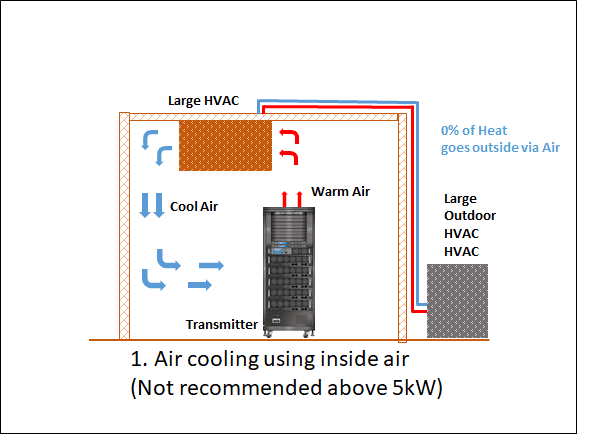 It could be argued that liquid cooled is better suited to hot climates and air cooled to cold climates. With liquid cooled transmitters in the winter the building will most likely be required to be heated which counterbalances some of the savings from having the heat exchanger outside. In the summer with air cooled transmitters the HVAC will work much harder and the maintenance and electrical costs will be higher. A failed HVAC system would cause the air cooled transmitter to reduce power or, in the worst case, switch off. Likewise any leakage or potential freezing of pipes on a liquid cooled transmitter will have catastrophic repercussions.
It could be argued that liquid cooled is better suited to hot climates and air cooled to cold climates. With liquid cooled transmitters in the winter the building will most likely be required to be heated which counterbalances some of the savings from having the heat exchanger outside. In the summer with air cooled transmitters the HVAC will work much harder and the maintenance and electrical costs will be higher. A failed HVAC system would cause the air cooled transmitter to reduce power or, in the worst case, switch off. Likewise any leakage or potential freezing of pipes on a liquid cooled transmitter will have catastrophic repercussions.
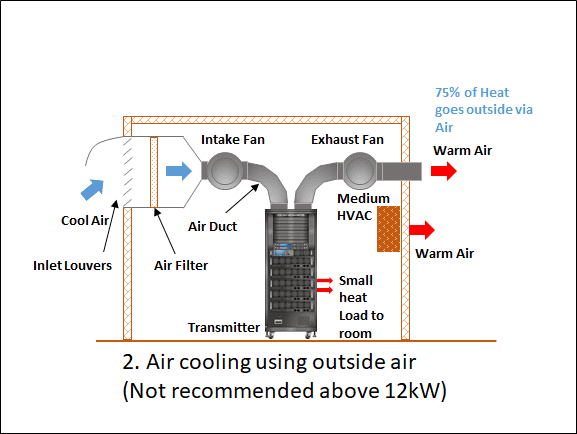 It is a recommendation of this author that all conditions being the same, transmitters above 12kW should be liquid cooled, and in most cases for Transmitter Power Outputs (TPO) less than 12kW, air cooled should be chosen. Of course there are exceptions and special considerations; for instance, if the transmitter is located in a high pollution area, or near an ocean, a liquid cooled transmitter should be employed. If the average ambient temperature is above 80 degrees for more than 7 months a year then a liquid cooled transmitter again would be the better choice. Lastly, depending on the level of engineering staff available, air cooled would be recommended if high level qualified engineers are not easily accessible.
It is a recommendation of this author that all conditions being the same, transmitters above 12kW should be liquid cooled, and in most cases for Transmitter Power Outputs (TPO) less than 12kW, air cooled should be chosen. Of course there are exceptions and special considerations; for instance, if the transmitter is located in a high pollution area, or near an ocean, a liquid cooled transmitter should be employed. If the average ambient temperature is above 80 degrees for more than 7 months a year then a liquid cooled transmitter again would be the better choice. Lastly, depending on the level of engineering staff available, air cooled would be recommended if high level qualified engineers are not easily accessible.
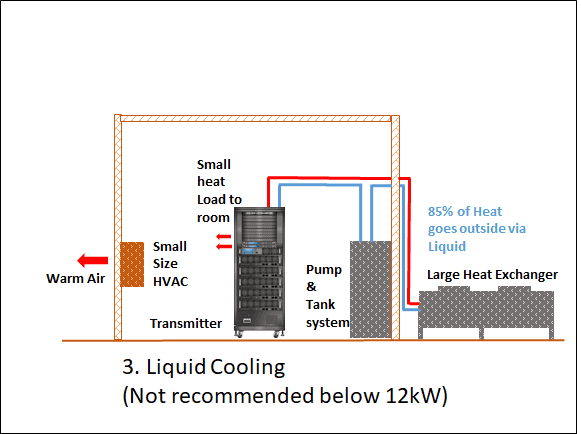 Air cooled is for practical reasons limited to 10-15kW or less, whereas liquid cooled has a power capability of up to 100kW, but is not practical at powers of 2-4kW and lower and not recommended in most cases between 4-12kW.
Air cooled is for practical reasons limited to 10-15kW or less, whereas liquid cooled has a power capability of up to 100kW, but is not practical at powers of 2-4kW and lower and not recommended in most cases between 4-12kW.
Perry Priestley is a board member of the Advanced Television Broadcasting Alliance. He can be reached at [email protected].



